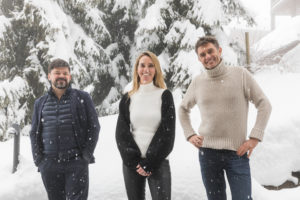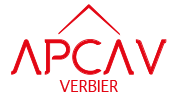
Anneliek, you founded the Verbier Art Summit some ten years ago. Could you tell us how it was created and how it stands out from other international art events?
The Verbier Art Summit was founded in 2014 in close partnership with the Verbier Tourist Office and Commune with the idea of creating a non-commercial art platform that would focus solely on the cultural value of art. Together with Beatrix Ruf, who was the director of the Kunsthalle in Zürich at the time, and a group of Verbier-based secondary home owners (our Founding Members), we created an art think tank—a space where artists, thought leaders, and the public can come together to discuss pressing global issues. Unlike traditional art fairs, where the focus is on sales, the Summit is all about ideas, dialogue, and connection. And of course, the stunning Alpine setting makes it a truly unique environment for inspiration and reflection.
Every year, we collaborate with a renowned international museum director that brings together a ‘dream team’ of artists and thinkers around a big social theme. To date, we collaborated with the Stedelijk Museum from Amsterdam, Moderna Museet from Stockholm, Pinacoteca from São Paulo, Dia Art Foundation from New York and the upcoming edition on 4 & 5 April is curated by Philip Tinari, director of the UCCA Center for Contemporary Art in China.
What will be the theme of the 2025 edition, and why was this topic chosen? What key issues do you aim to highlight this year?
The 2025 Verbier Art Summit theme is:
QUARTER LIFE CRISIS
Art in a World on the Brink
This Summit will examine the uncertainty of our contemporary moment—a period defined by shifting geopolitical powers, the rapid acceleration of digital technology, and the evolving articulation of identities. These topics, set against the backdrop of the inspiring Swiss Alps, offer a unique space for critical conversations about art’s role in navigating crisis and transformation, and will be explored throughout the Summit’s two-day programme of Talks, Debates, and Cultural events.
Philip Tinari brings a wealth of curatorial expertise from his role at the UCCA, China’s leading independent contemporary art institution. Reflecting on the theme, Tinari explains: “Taking its title from the pop-psychology name for the anxiety of young adulthood coined in the early 2000s, this edition of the Verbier Art Summit will bring together artists and thinkers from across geographies and generations to ask urgent questions about the geopolitical, digital, human, and institutional dimensions of the art world in the 21st century—to which there are no easy answers.”
Can you give us an overview of the artists, speakers, or key figures who will participate in this edition? Are there any must-attend events?
The Talks programme at the W Hotel and our Cultural Events programme can all be attended for free. The Talks include 20-minutes presentations by an incredible line-up of international speakers from diverse disciplines, including art, philosophy and science.
Some of the confirmed names include:
• Dana Awartani—Palestinian-Saudi Arabian artist
• Olaf Blanke—EPFL neuroscientist
• Cao Fei—Chinese multimedia artist
• Kyle Chayka—The New Yorker writer and author
• Claudia Comte—Swiss artist
• Clémentine Deliss—French-Austrian curator and scholar
• Elena Filipovic—Director of the Kunstmuseum Basel
• Yuk Hui—Hong Kong philosopher and theorist on technology
• Lawrence Lek—Malaysian Chinese artist and filmmaker
• Zanele Muholi—South African visual activist
• Wang Tuo—Chinese multidisciplinary artist
Each of these brilliant minds will bring a different perspective on how today’s fragmented world shapes contemporary art and culture. Dana Awartani and Wang Tuo are artists that work from cultural heritage, whilst Cao Fei and Lawrence Lek for example reflect on the rapid and transformative developmental changes that shape today’s society as well as the future. Claudia Comte is very engaged with sustainability, and Zanele Muholi focuses on Black queer identity, so there will be interesting ideas from many different angles!
In view of our ‘where global meets local’ campaign this year, the Summit organised 10 different cultural activities to experience all around Verbier. They include a snowy art walk through the Verbier 3-D Foundation Sculpture Park, an art market workshop by Christie’s, the EPFL+ECAL Lab project Ming Shan Digital Experience, an exhibition by 9 local artists around the Summit theme, a Verbier Festival talk with the young pianist Ekaterina Bonyushkina Music in the digital world: the rules are broken, and a film programme from the Biennale de l’Image en Mouvement by the Centre d’Art Contemporain Genève, including a conversation with Lawrence Lek on his work Empty Rider (2024). In addition, local school children will also collaborate with the partnering museum UCCA Center for Contemporary Art, and their art will be displayed both during the Summit Talks programme. The Summit also spoke to the Classe of 2000, local young people who are now in their ‘quarter life’, and asked them about their ideas for the future. The outcome of these discussions will also be presented as art during the Summit.
How does the Verbier Art Summit contribute to the cultural life of Verbier and its influence? How can APCAV members get involved or benefit from this event?
The Summit is very much a part of Verbier’s cultural ecosystem, and we would love APCAV members to join the 2025 Verbier Art Summit.
In addition to the free programme, the Summit also has an extended two-day Debating programme, whereby a diverse group of 150 international art world stakeholders—including collectors, innovators, thinkers, artists, museum directors, curators, art historians, critics, gallerists, and art consultants—join the invited speakers in small-group discussions that spark new ideas. These Debates continue over a private dinner and a lunch in the chalets of our Founding Members, and culminate in a special closing dinner on 5 April. All Summit Members donate towards the non-profit platform, ensuring not only the success of the Summit, but also allowing us to continue our offering of free public access to the Talks, and to inspire audiences worldwide through our annual publication and the virtual Summit platform.
For APCAV members interested in such deeper engagement, the Summit is happy to offer a unique chance to join our international Member community that supports innovation and change! To express interest, contact info@verbierartsummit.org
The Verbier Art Summit takes place in a unique alpine environment. What role does sustainability and art in mountain landscapes play in the event’s discussions?
Sustainability is at the heart of what we do, especially since our Resource Hungry Summit in 2020, and we continue demonstrating this commitment via our meaningful, respected leadership platform, which promotes art education and global solidarity, as well as climate awareness through implication of best practices.
This is why the Summit aims to attract a large international audience through its (free) virtual Summit, and to be open (and free) to all who are in Verbier and would like to attend the Talks and Cultural Programme.
One of the biggest sustainability issues in the art world is the environmental impact of materials and production processes, which does not apply to the Summit. Another issue that we are acutely aware of is the impact of travel. All our speakers use the train if they are within 6 hours travelling distance, and also take the train when they arrive at Geneva airport by plane (economy flights only). We actually recommend all Summit attendees to travel by train, especially as the ride along Lake Geneva is not only incredibly beautiful, but it also provides the time and space to think and get you into a fresh mindset even before you arrive at the Summit!
◦
What are your future plans for the Summit? How do you see its evolution in Verbier and its relationship with the local community?
We have exciting ideas for the future! Some of our goals include:
• A year-round virtual Summit platform to continue discussions beyond the annual event in Verbier. In November 2025, we will for example launch the 2025 Summit publication at our partnering museum UCCA Center for Contemporary Art, with a Micro-Summit around the same theme, discussing Quarter Life Crisis in a local context, with local artists and local thinkers. The content of this Micro-Summit will be shared on the virtual Summit.
• Our educational partnerships to engage schools and universities are currently limited to one of each per year, and we would like to expand this programme to multiple schools and universities.
• We have always collaborated with Verbier’s other cultural institutions, and are keen to further build the Summit’s impact together with these local partners.
I see the Summit evolving into a permanent art hub for ideas and exchange, deeply connected with both the local and global community.
Verbier, March 2025
